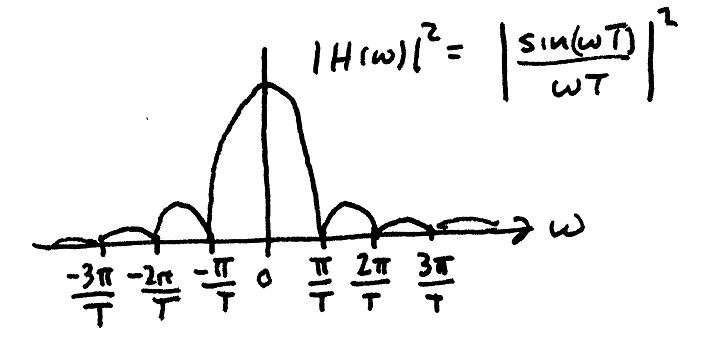| Line 40: | Line 40: | ||
''False.'' | ''False.'' | ||
| − | *[[ECE 600 Finals MRB 1992 Final|1992 | + | *[[ECE 600 Finals MRB 1992 Final|1992 Final]] |
*[[ECE 600 Finals MRB 1994 Final|1994 Final]] | *[[ECE 600 Finals MRB 1994 Final|1994 Final]] | ||
*[[ECE 600 Finals MRB 2004 Final|2004 Spring Final]] | *[[ECE 600 Finals MRB 2004 Final|2004 Spring Final]] | ||
Revision as of 12:26, 19 November 2010
6 Finals
Example (Important because it was dealt in the class)
Let $ \mathbf{X}\left(t\right) $ be a WSS random process with PSD $ S_{\mathbf{XX}}\left(\omega\right) $ and let $ \mathbf{Y}\left(t\right) $ be the “smoothed” random process given by $ \mathbf{Y}\left(t\right)=\frac{1}{2T}\int_{t-T}^{t+T}\mathbf{X}\left(\alpha\right)d\alpha. $
This can be represented by a LTI system
with impulse response $ h\left(t\right)=\frac{1}{2T}\mathbf{1}_{\left[-T,T\right]}\left(t\right) $. What is the PSD $ S_{\mathbf{YY}}\left(\omega\right) $ of $ \mathbf{Y}\left(t\right) $ ?
Solution
$ H\left(\omega\right)=\int_{-\infty}^{\infty}h\left(t\right)e^{-i\omega t}dt=\int_{-\infty}^{\infty}\frac{1}{2T}\mathbf{1}_{\left[-T,T\right]}\left(t\right)e^{-i\omega t}dt=\frac{1}{2T}\int_{-T}^{T}e^{-i\omega t}dt $$ =\left.\frac{1}{2T}\frac{e^{-i\omega t}}{-i\omega}\right|_{-T}^{T}=\frac{1}{2T}\frac{e^{-i\omega T}-e^{i\omega T}}{-i\omega}=\frac{1}{2T}\frac{\left(\cos\omega T-i\sin\omega T\right)-\left(\cos\omega T+i\sin\omega T\right)}{-i\omega} $$ =\frac{1}{2T}\frac{2\sin\omega T}{\omega}=\frac{\sin\omega T}{\omega T}. $
$ S_{\mathbf{YY}}\left(\omega\right)=S_{\mathbf{XX}}\left(\omega\right)\left|H\left(\omega\right)\right|^{2}=S_{\mathbf{XX}}\left(\omega\right)\left|\frac{\sin\omega T}{\omega T}\right|^{2}. $
Note that $ h\left(t\right) $ acts as a crude low-pass filter that attenuates high-frequency power.
Example (True or False)
Let $ \mathbf{X}\left(t\right) $ and $ \mathbf{Y}\left(t\right) $ be two zero-mean statistically independent, jointly wide-sense stationary random processes. Then the cross-correlation function $ R_{\mathbf{XY}}\left(\tau\right)=0 $ .
Solution
True.
$ R_{\mathbf{XY}}\left(t_{1},t_{2}\right)=E\left[\mathbf{X}\left(t_{1}\right)\mathbf{Y}^{*}\left(t_{2}\right)\right]=E\left[\mathbf{X}\left(t_{1}\right)\right]E\left[\mathbf{Y}^{*}\left(t_{2}\right)\right]=0\cdot0=0. $
Example (True or False)
The cross-correlation function $ R_{\mathbf{XY}}\left(\tau\right) $ of two real, jointly wide-sense stationary random process $ \mathbf{X}\left(t\right) $ and $ \mathbf{Y}\left(t\right) $ is an even function of $ \tau $ .
Solution
False.



